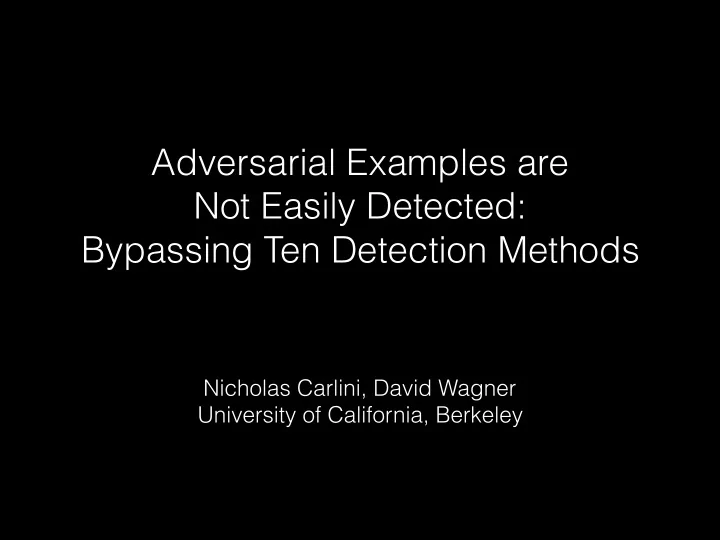

Adversarial Examples are Not Easily Detected: Bypassing Ten Detection Methods Nicholas Carlini, David Wagner University of California, Berkeley
Background
Neural Networks • I assume knowledge of neural networks ... • This talk: neural networks for classification • Specifically image-based classification
Background: Adversarial Examples • Given an input X classified as label T ... • ... it is easy to find an X ′ close to X • ... so that F(X ′ ) != T
Constructing Adversarial Examples • Formulation: given input x, find x ′ where minimize d(x,x ′ ) + L(x ′ ) such that x ′ is "valid" • Where L(x ′ ) is a loss function minimized when F(x ′ ) != T and maximized when F(x ′ ) = T • Solve via gradient descent
MNIST Normal Adversarial 7 8 9 8
CIFAR-10 Normal Adversarial Truck Airplane
This is decidedly bad
But also: ripe opportunity for research!
Mitigating Evasion Attacks to Deep Neural Networks via Region-based Classification. Xiaoyu Cao, Neil Zhenqiang Gong APE-GAN: Adversarial Perturbation Elimination with GAN. Shiwei Shen, Guoqing Jin, Ke Gao, Yongdong Zhang A Learning Approach to Secure Learning. Linh Nguyen, Arunesh Sinha EAD: Elastic-Net Attacks to Deep Neural Networks via Adversarial Examples. Pin-Yu Chen, Yash Sharma, Huan Zhang, Jinfeng Yi, Cho-Jui Hsieh Ensemble Methods as a Defense to Adversarial Perturbations Against Deep Neural Networks. Thilo Strauss, Markus Hanselmann, Andrej Junginger, Holger Ulmer MagNet: a Two-Pronged Defense against Adversarial Examples. Dongyu Meng, Hao Chen CuRTAIL: ChaRacterizing and Thwarting AdversarIal deep Learning. Bita Darvish Rouhani, Mohammad Samragh, Tara Javidi, Farinaz Koushanfar Efficient Defenses Against Adversarial Attacks. Valentina Zantedeschi, Maria-Irina Nicolae, Ambrish Rawat Learning Adversary-Resistant Deep Neural Networks. Qinglong Wang, Wenbo Guo, Kaixuan Zhang, Alexander G. Ororbia II, Xinyu Xing, Xue Liu, C. Lee Giles SafetyNet: Detecting and Rejecting Adversarial Examples Robustly. Jiajun Lu, Theerasit Issaranon, David Forsyth Enhancing Robustness of Machine Learning Systems via Data Transformations. Arjun Nitin Bhagoji, Daniel Cullina, Bink Sitawarin, Prateek Mittal Towards Deep Learning Models Resistant to Adversarial Attacks. Aleksander Madry, Aleksandar Makelov, Ludwig Schmidt, Dimitris Tsipras, Adrian Vladu Towards Robust Deep Neural Networks with BANG. Andras Rozsa, Manuel Gunther, Terrance E. Boult Deep Variational Information Bottleneck. Alexander A. Alemi, Ian Fischer, Joshua V. Dillon, Kevin Murphy NO Need to Worry about Adversarial Examples in Object Detection in Autonomous Vehicles. Jiajun Lu, Hussein
Research Question: Which of these defenses are robust?
Focus of this talk: detection schemes
Normal Classifier 7 Classifier
Normal Classifier 8 Classifier
Detector & Classifier 7 Detector Classifier
Detector & Classifier Detector Classifier
This Talk: 1. How to evaluate a defense 2. Comment on explored directions
Defense #1: PCA-based detection Dan Hendrycks and Kevin Gimpel. 2017. Early Methods for Detecting Adversarial Images. In International Conference on Learning Representations (Workshop Track)
PCA-based detection • Hypothesis: Adversarial examples rely on later principle components • ... and valid images don't ... • ... so let's detect use of high components
Normal Adversarial
It works!
Attack: Only modify regions of the image that are also used in normal images.
Original Adversarial (unsecured) Adversarial (with detector)
Lesson 1: Separate the artifacts of one attack vs intrinsic properties of adversarial examples
Lesson 2: MNIST is insufficient CIFAR is better
Defense #2: Additional Neural Network Detection Jan Hendrik Metzen, Tim Genewein, Volker Fischer, and Bastian Bischo. 2017. On Detecting Adversarial Perturbations. In International Conference on Learning Representations.
Normal Training ( , ) 7 F Training ( , ) 3
Adversarial Training ( , ) 7 Attack ( , ) 3 ( , ) n ( , ) n
Adversarial Training ( , ) y G Training ( , ) y ( , n) n n ( , n)
Sounds great.
Sounds great. But we already know it's easy to fool neural networks ...
... so just construct adversarial examples to 1. be misclassified 2. not be detected
Breaking Adversarial Training • minimize d(x,x ′ ) + L(x ′ ) such that x ′ is "valid" • Old: L(x ′ ) measures loss of classifier on x ′
Breaking Adversarial Training • minimize d(x,x ′ ) + L(x ′ ) + M(x ′ ) such that x ′ is "valid" • Old: L(x ′ ) measures loss of classifier on x ′ • New: M(x ′ ) measures loss of detector on x ′
Original Adversarial (unsecured) Adversarial (with detector)
Lesson 3: Minimize over (compute gradients through) the full defense
Defense #3: Network Randomization Reuben Feinman, Ryan R Curtin, Saurabh Shintre, and Andrew B Gardner. 2017. Detecting Adversarial Samples from Artifacts.
Randomized Classifier 7 7 Classifier
Randomized Classifier 3 2 6 7 Classifier
Breaking Randomization • minimize d(x,x ′ ) + L(x ′ ) such that x ′ is "valid" • Old: L(x ′ ) measures loss of network on x ′
Breaking Randomization • minimize d(x,x ′ ) + E[L(x ′ )] such that x ′ is "valid" • Old: L(x ′ ) measures loss of network on x ′ • Now: E[L(x ′ )] expected loss of network on x ′
Original Adversarial (unsecured) Adversarial (with detector)
Original Adversarial (unsecured) Adversarial (with detector)
Evaluation Lessons 1. Don't evaluate only on MNIST 2. Minimize over the full defense 3. Use a strong iterative attack 4. Release your source code! https://nicholas.carlini.com/nn_breaking_detection
Recommend
More recommend